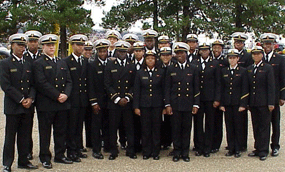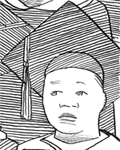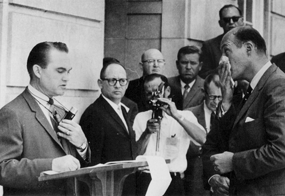Special Report: George W. Bush, the NAACP, and the Persistent Damage to Black Higher Education
 Last month President Bush addressed the annual convention of the National Association for the Advancement of Colored People (NAACP) in Washington. Last month President Bush addressed the annual convention of the National Association for the Advancement of Colored People (NAACP) in Washington.
In his address to the convention the president made an appeal for NAACP votes. He cited his support for historically black colleges and universities, his appointment of several African Americans to high-ranking positions in his administration, and his support for the renewal of the Voting Rights Act.
Clearly, Bush’s appearance at the NAACP convention was driven by political considerations. In past years the GOP believed it could win more white votes in stonewalling black aspirations than it would gain by appealing to black votes. Now with the GOP facing the possible loss of one or both houses of Congress in the coming midterm elections, President Bush’s GOP is fighting for every vote it can get, and now that includes those of African Americans.
But many NAACP members appear to have been pacified by the president’s rhetoric. This should not have been the case. The administration’s record on support for measures that would improve the educational opportunities for African Americans has been, and continues to be, dismal. In fact, the president’s policies have inflicted serious harm.
Here is a link to the JBHE special report detailing the serious damage the president’s policies have done to African-American aspirations for higher education.
  |
“These aren’t typical colleges. They are a vital link to the fabric of African-American culture.”
— Former President George H.W. Bush, announcing the new “Wave of Hope” campaign to raise funds to rebuild the campuses of seven black colleges and universities damaged by Hurricane Katrina in August 2005
|
How Proposition 209 Has Impacted Business School Education for African Americans in California
 Readers of JBHE are well aware of the effect of Proposition 209 on black enrollments at the most selective undergraduate campuses of the University of California. This public referendum, enacted in 1996, bans the consideration of race in admissions and hiring decisions at all state-operated colleges and universities in California. Readers of JBHE are well aware of the effect of Proposition 209 on black enrollments at the most selective undergraduate campuses of the University of California. This public referendum, enacted in 1996, bans the consideration of race in admissions and hiring decisions at all state-operated colleges and universities in California.
But the bans on race-sensitive admissions has had an even greater impact on black enrollments at business schools in the state. JBHE research shows that at the Haas School of Business at the University of California at Berkeley there were only two blacks among the 491 entering students in 2005. They made up only 0.4 percent of the first-year class. At the business school at the University of California at Los Angeles there were only six black students among the 330-member entering class.
The impact of Proposition 209 is also felt at the faculty level at state-run business schools in California. There are no blacks whatsoever among the 75 faculty members at the Haas School of Business at the University of California at Berkeley.
CUNY Fights Back, But the Statistics Don’t Lie
 An item in the August 3 edition of the JBHE Weekly Bulletin disclosed that black enrollments at the most selective campuses of the City University of New York were down significantly since the university announced in 1998 that it was eliminating remedial education courses and raising its admissions standards. The JBHE story was carried by The New York Times, The New York Post, New York Sun, The Chronicle of Higher Education, and other media outlets. An item in the August 3 edition of the JBHE Weekly Bulletin disclosed that black enrollments at the most selective campuses of the City University of New York were down significantly since the university announced in 1998 that it was eliminating remedial education courses and raising its admissions standards. The JBHE story was carried by The New York Times, The New York Post, New York Sun, The Chronicle of Higher Education, and other media outlets.
After the JBHE news item appeared, the City University of New York issued a press release defending its record on black enrollments. While not disputing JBHE’s figures, CUNY said that black enrollments at all 11 CUNY campuses were up 1.3 percent from 2001. What the release neglected to point out was that enrollments for other ethnic groups were up considerably more than the growth in black enrollments.
The press release ignored JBHE’s contention that the significant drop in black enrollments at the most selective campuses would have a negative impact on blacks seeking graduate education and employment at some of the nation’s most prestigious corporations. A degree from Hunter College or Baruch College is highly valued by graduate school administrators and corporate recruiters. Yet black enrollments at these two important colleges are down by more than 25 percent.
No Change in the Large Racial Scoring Gap on the ACT Test
 The American College Testing Program announced that high school students who graduated in 2006 improved their average score on the ACT standardized test for college admission by 0.2 points to 21.1. (The ACT is scored on a scale of 1 to 36.) This is the largest average score increase in the past two decades. The American College Testing Program announced that high school students who graduated in 2006 improved their average score on the ACT standardized test for college admission by 0.2 points to 21.1. (The ACT is scored on a scale of 1 to 36.) This is the largest average score increase in the past two decades.
But there was no change in the racial scoring gap between blacks and whites. The average white composite score of 22.0 was about 14 percent higher than the average black score of 17.1 on the ACT’s 36-point scoring grid. The racial scoring gap was identical to the disparity between blacks and whites of a year ago.
Benedict College Is Deep in the Red: But the Black College Is Opening a Multimillion-Dollar Football Stadium
 In July, Moody’s Investor Service downgraded the debt issues of Benedict College on two separate occasions. Benedict is a historically black educational institution in Columbia, South Carolina. In July, Moody’s Investor Service downgraded the debt issues of Benedict College on two separate occasions. Benedict is a historically black educational institution in Columbia, South Carolina.
Moody’s now ranks Benedict’s debt at four levels below investment grade. In downgrading Benedict’s debt, Moody’s said that “declines in enrollment, two years of deficit operating margins, increased borrowing, and thin unrestricted cash” were all reasons contributing to the college’s problems.
Many private historically black colleges and universities are in deep financial trouble. But what is most troubling about the situation at Benedict College is that while it is mired in financial difficulty it has proceeded in the construction of a new $11-million football stadium. Even the stadium project is behind schedule. The new stadium was scheduled to host its first game this Saturday. But because construction is not complete, the first game and a black-tie grand opening celebration will not be held until late September.

Southern Methodist University

Assistant Professor of African Diaspora/African American Literature
The Department of English at Southern Methodist University seeks a tenure-track assistant professor in African Diaspora literatures of any period and/or African American literature before the twentieth century.
In August 2007 the greatly augmented SMU English Department (with 3 new endowed chairs) will admit its first class of six students to its new Ph.D. program; this small, select, exceptionally well-funded doctoral program will build on the departments newly revised undergraduate curriculum and existing M.A. degree, with their recognized strengths in literary studies and creative writing. Candidates for this position should therefore have a demonstrated commitment to teaching and excellent potential as a publishing scholar. The Ph.D. from a literature department or appropriate area studies program must be completed no later than August 15, 2007.
For full consideration, applicants must send a CV and a letter outlining teaching and research interests to Ezra Greenspan, Chair, Department of English, P.O. Box 750435, Southern Methodist University, Dallas, TX 75275-0435, postmarked no later than October 20, 2006, although the recruitment committee will continue to accept applications until the position is filled. Send no writing samples at this time. We will be interviewing at MLA and will notify applicants of our decisions after the position is filled.
SMU will not discriminate on the basis of race, color, religion, national origin, sex, age, disability, or veteran status. SMUs commitment to equal opportunity includes nondiscrimination on the basis of sexual orientation. We invite applications from women and minorities.

In Memoriam
Charles Sumner Lofton (1912-2006)
Charles Sumner Lofton, who shepherded thousands of young blacks toward higher education as principal of Dunbar High School in Washington, D.C., has died from congestive heart failure at his home in the nation’s capital. He was 94 years old.
Lofton, who was himself a graduate, was principal of Dunbar High School from 1948 to 1964. During the 1950s, when all black students in the district were racially segregated, Dunbar sent 80 percent of its graduates on to higher education.
Lofton was a graduate of Howard University, where he also earned a master’s degree in history. After teaching briefly at what is now Virginia State University, during World War II Lofton taught history at Armstrong High School in Washington and in a special Army training program at Howard University.
After his appointment as principal of Dunbar High School in 1948, Lofton insisted on high academic standards, neat dress, and proper behavior. He instilled confidence in his students that they could succeed, even in a racially segregated society.
After his retirement from the city school system, Lofton served for 10 years as executive assistant to the president of what is now the University of the District of Columbia.
Robert Louis McCullough (1942-2006)
Robert McCullough, the leader of the group of college student civil rights protesters dubbed the Friendship Nine, died earlier this month at his home in Rock Hill, South Carolina. He was 64 years old.
McCullough and eight fellow students at Friendship Junior College in Rock Hill followed the lead of black college students who began the lunch counter sit-in movement in Greensboro, North Carolina. But the Friendship Nine brought further attention to the movement when their strategy of “jail, no bail” landed them at the York County Prison Farm where they were assigned to a chain gang. The Friendship Nine received national press attention for their courageous stand and the harsh treatment they received in the South Carolina penal system. This tactic undoubtedly revealed the injustice of Jim Crow to millions of Americans and accelerated the progress of the civil rights movement.
After college McCullough worked as a computer technician and a volunteer firefighter.
Mary Starke Harper (1919-2006)
Mary Starke Harper, the last living member of the health care team that conducted the Tuskegee Syphilis Study, died from cancer late last month at her home in Columbus, Georgia. She was 86 years old.
Harper was a nursing student at what is now Tuskegee University in the early 1940s, serving as the personal nurse to George Washington Carver when she was assigned to care for the black men who had contracted syphilis. The black men went untreated despite the fact that the government doctors knew the disease could be cured by penicillin. Government researchers then tracked the progress of the disease. Harper was unaware of the true nature of the Tuskegee study until 1972.
Harper’s career in health care spanned more than 65 years. She spent 30 years with the Department of Veterans Affairs and more than two decades at the U.S. Department of Health and Human Services. While there, she organized the National Institutes of Health’s minority fellowship program which has provided funding for thousands of minority students who sought training in medicine, nursing, dentistry, and other health-care professions.
Appointments
 • Marcus Martin, chair of the department of emergency medicine at the University of Virginia, was named interim assistant vice president in the office of the vice president and chief officer for diversity and equity at the university. He will serve in the post for one year before returning full-time to the medical school. • Marcus Martin, chair of the department of emergency medicine at the University of Virginia, was named interim assistant vice president in the office of the vice president and chief officer for diversity and equity at the university. He will serve in the post for one year before returning full-time to the medical school.
• Herma Williams was named vice provost at Fresno Pacific University in California. Williams, who is of Panamanian and Jamaican descent, was associate provost at Gordon College in Wenham, Massachusetts.
Williams is a graduate of Southern Illinois University where she also earned a master’s degree in education. She holds an educational doctorate from Iowa State University.
Grants
• Delaware State University, the historically black educational institution in Dover, received a $25,000 grant from Delmarva Power for the endowed scholarship program the utility company founded at the university eight years ago.
• UGS Corporation donated $1 billion worth of software to 50 colleges and universities in the Gulf Coast region that were impacted by Hurricane Katrina and Hurricane Rita in the fall of 2005. About $225 million worth of software will be donated to historically black colleges and universities.
 • The University of North Carolina at Chapel Hill received a five-year, $6.2 million grant from the W.K. Kellogg Foundation for a program to develop teaching methods and other strategies to combat academic underachievement by young black and other minority males. The project will be under the direction of Oscar A. Barbarin, the L. Richardson and Emily Preyer Bicentennial Professor for Strengthening Family at the UNC School of Social Work. • The University of North Carolina at Chapel Hill received a five-year, $6.2 million grant from the W.K. Kellogg Foundation for a program to develop teaching methods and other strategies to combat academic underachievement by young black and other minority males. The project will be under the direction of Oscar A. Barbarin, the L. Richardson and Emily Preyer Bicentennial Professor for Strengthening Family at the UNC School of Social Work.
|
The Snail-Like Progress of Blacks Into Full-Time Faculty Positions at U.S. Colleges and Universities
A new report from the U.S. Department of Education finds that in 2003 there were more than 31,700 African Americans holding full-time faculty positions at U. S. colleges and universities. Only 51 percent of all black faculty were employed on a full-time basis. In 1993, 57 percent of the black faculty held full-time positions. For whites, 55 percent of the faculty was full-time in 2003 compared to 60 percent in 1993.
Blacks were 5.2 percent of the full-time faculty in 2003. In 1993 blacks were 4.7 percent of the full-time faculty. This is some progress but at best it can be regarded as snail-like. At JBHE we have extrapolated the gains in black full-time faculty over the past decade forward into the future. We find that it will take 160 years for the black percentage of full-time faculty at U.S. colleges and universities to equal the black percentage of the U.S. work force in general.
Naval Academy Will No Longer Permit Student Sponsors to Specify Which Race They Prefer
For the past 30 years the United States Naval Academy in Annapolis, Maryland, has conducted a sponsors program where local families in the community provide a “home away from home” for students at the academy. Sponsors typically have the students over for dinner, take them on family outings, treat them to movies or sporting events, invite them to holiday functions, or just give them a place to get away for a weekend or overnight.
Until now sponsors could stipulate on the application form that they wanted a student of a particular race. After a request from the local chapter of the NAACP, the Naval Academy has now abandoned this practice. Sponsors may still request a student of a particular gender.

 A Large Gender Gap in Black Bachelor’s Degree Awards: But Black Men Are Also Making Gains A Large Gender Gap in Black Bachelor’s Degree Awards: But Black Men Are Also Making Gains
In the 2003-04 academic year, black women earned 87,390 bachelor’s degrees, almost double the number earned by black men. Black women now earn two thirds of all bachelor’s degrees obtained by African Americans. But do not be mistaken. Contrary to press reports and common opinion, black men too have made progress. Over the past decade, the number of bachelor’s degrees earned by black men is up more than 40 percent. This is triple the gain posted by white men, but it still pales in comparison to the gains posted by black women.

University of Missouri-Columbia

Women's and Gender Studies Program - Assistant Professor
The Women's and Gender Studies Program (WGST) at the University of Missouri-Columbia seeks a scholar whose primary research and teaching interests focus on African American and gender topics. This is a tenure track full-time assistant professor position beginning in August 2007. This position could be a joint appointment in WGST and another department within the university. Applicants should have research and teaching interests in the various intersections of race, ethnicity, class, gender, age, sexuality, disabilities and cultural difference. WGST, which has an interdisciplinary curriculum and an active faculty, is particularly interested in candidates who will contribute to building a diverse program by offering courses, conducting research, and supervising students on race and gender issues.
Requirements include a Ph.D. or an advanced A.B.D., evidence of ability to conduct a program of research on African American and gender topics, and commitment to teaching at the undergraduate and graduate levels.
The University of Missouri-Columbia is committed to increasing the diversity of the college community and curriculum. In relation to this, candidates who support those goals are encouraged to apply and to identify their relevant strengths and experiences, indicating these in the cover letter. We are interested in candidates who work in the intersections of African American Studies and Women's & Gender Studies.
To apply, submit a cover letter that includes a statement of your research, future research program and teaching interests or experience, a curriculum vitae, three letters of recommendation, and publication(s) or writing sample(s) to:
Dr. Tola Olu Pearce, Chair of Search Committee
Women's and Gender Studies Program
325 GCB
University of Missouri-Columbia
Columbia, Missouri 65211
The review of applicants will begin on November 1, 2006 and continue until the position is filled. Please direct questions to Dr Tola Pearce (pearcei@missouri.edu), Dr. Jacquelyn Litt (Littj@missouri.edu) Director of WGST, or Administrative Assistant Shelda Eggers at (573) 882-2703 or (EggersS@missouri.edu). Further information about the WGST program can be found on the website: http://wgst.missouri.edu
The University of Missouri is an equal opportunity/Affirmative Action employer.

University of Iowa Plans to Resurrect Its Black Studies Department
 Linda Maxson, the dean of the College of Liberal Arts and Sciences at the University of Iowa, has announced that the black studies program at the university will regain departmental status by 2008. Linda Maxson, the dean of the College of Liberal Arts and Sciences at the University of Iowa, has announced that the black studies program at the university will regain departmental status by 2008.
The program initially achieved departmental status in 1969. In 2004, what was called the African-American world studies department was disbanded after several faculty members left the university. When reestablished in 2008, the new department will be called African-American studies.
Undergraduate student enrollments in the program dropped to 15 in the spring 2006 semester. There are no graduate students in black studies at the University of Iowa at the current time. For the coming academic year there will be 14 faculty members who will teach in the program, up from four in 2005.
The university hopes that a revitalized black studies department will help recruit a larger number of black students to campus. The latest Department of Education figures show that blacks make up 2.2 percent of all undergraduate enrollments at the University of Iowa. Blacks are 2.1 percent of the population in the state of Iowa.
Cornell Sees 10 Percent Jump in Black Freshmen
 For the fourth consecutive year Cornell University has seen an increase in the percentage of black students in its entering class. There are 192 black freshman students enrolling this fall for the 2006-07 academic year. This is up nearly 10 percent from a year ago. For the fourth consecutive year Cornell University has seen an increase in the percentage of black students in its entering class. There are 192 black freshman students enrolling this fall for the 2006-07 academic year. This is up nearly 10 percent from a year ago.
Blacks are 5.9 percent of this year’s freshman class, compared to 5.6 percent a year ago. This is the highest percentage of black students in Cornell’s first-year class since JBHE first starting collecting freshman enrollment data in 1992.
The Higher Education of the ABA’s New Litigation Chief
 Kim J. Askew, partner with the law firm Hughes & Luce of Austin, Texas, was sworn in as chair of the American Bar Association’s Section of Litigation at the organization’s annual convention in Hawaii earlier this month. Askew is the first African American to serve as chair of the litigation section, the largest division of the ABA. Kim J. Askew, partner with the law firm Hughes & Luce of Austin, Texas, was sworn in as chair of the American Bar Association’s Section of Litigation at the organization’s annual convention in Hawaii earlier this month. Askew is the first African American to serve as chair of the litigation section, the largest division of the ABA.
Askew is a summa cum laude graduate of Knoxville College, the historically black educational institution in Tennessee. She went on to earn her law degree from the Georgetown University Law Center.
Education Commission Urges Huge Increase in Pell Grant Funding
The 19-member Commission on the Future of Higher Education is prepared to issue its final report to Secretary of Education Margaret Spellings next month. Among the recommendations the panel will offer the Bush administration is a 45 percent increase in funding for the Pell Grant program for low-income college students. The commission members agreed that a Pell Grant should cover at least 70 percent of the cost of higher education at a state-operated college or university. At the present time, the maximum Pell Grant award covers about 40 percent of the average annual cost of attending such educational institutions.
 The commission’s recommendations will likely fall on deaf ears. Both the Bush administration and the GOP-controlled Congress have been unwilling to increase the maximum Pell Grant award by even a small amount for the past five years. Thus it is almost certain that the proposal for a major increase in the maximum Pell Grant award will be dead on arrival at the Department of Education. The commission’s recommendations will likely fall on deaf ears. Both the Bush administration and the GOP-controlled Congress have been unwilling to increase the maximum Pell Grant award by even a small amount for the past five years. Thus it is almost certain that the proposal for a major increase in the maximum Pell Grant award will be dead on arrival at the Department of Education.
Among the members of the panel was Louis Sullivan, president emeritus of the Morehouse School of Medicine and former secretary of the U.S. Department of Health and Human Services.
Black Enrollments at the University of Georgia: Some Progress But Still a Long Way to Go
 In 2003 blacks made up just 4.5 percent of the freshman class at the University of Georgia. Black first-year enrollments were down by more than 25 percent from the year earlier. In 2003 blacks made up just 4.5 percent of the freshman class at the University of Georgia. Black first-year enrollments were down by more than 25 percent from the year earlier.
In the next year, 2004, the University of Georgia mounted an intense recruiting plan to increase the number of black applicants. It also made a more serious effort to encourage the black students it accepted to enroll. As a result, in 2005 black first-year students at the university increased by nearly 40 percent. Blacks were 7.6 percent of the entering class on the University of Georgia campus.
This fall the university has maintained, but not improved upon, its progress. Black first-year enrollments are nearly the same as a year ago.
It must be kept in mind that blacks are nearly 29 percent of the population in Georgia. Therefore, the black percentage of the incoming students at the university is only one fourth the level that would prevail if racial parity were to exist on the Athens campus.
  |
1,281 Total number of professional degrees in optometry awarded in the United States in 2003.
33 Total number of professional degrees in optometry awarded to blacks in the United States in 2003.
source: U.S. Department of Education
|
What Will Happen to George Wallace’s “Schoolhouse Door”?
In June 1963 Governor George C. Wallace made his historic “stand in the schoolhouse door” in a show of defiance against a federal court which ordered the racial integration of the University of Alabama.
The Kennedy administration, represented by Assistant Attorney General Nicholas Katzenbach, agreed to permit Wallace to stage his show of defiance to federal authority but only after receiving assurances from the governor that he would not pull out the state highway patrol and leave the city in the hands of racist thugs.
Now, Foster Auditorium, where Wallace made his stand, has been closed after it was learned that asbestos was prevalent throughout the building. A major renovation would cost up to $15 million. The university has pledged to preserve the historic landmark of the civil rights movement but it is in no rush to do so. There is no plan to start renovation for at least three years.
“We have a set of priorities,” said university president Robert Witt. “Foster will have to wait.”

George Wallace making his famous stand in the schoolhouse door
at the University of Alabama on June 11,1963. At far right is
Deputy
Attorney
General Nicholas Katzenbach. (AP Images.)
|
 .
.